Challenges in the Management of Surgical Site Infections: Hong Kong
VerifiedAdded on 2022/11/23
|20
|6053
|256
Essay
AI Summary
This essay provides a comprehensive analysis of the challenges associated with the management of Surgical Site Infections (SSIs) in Hong Kong. It begins by defining SSIs, classifying their types, and outlining their signs and symptoms. The essay then delves into the microorganisms responsible for causing SSIs, including common bacteria like Pseudomonas, Staphylococcus, and Streptococcus, and discusses how these microorganisms spread and impact patients. It further explores infection prevention and control measures, such as patient education, antimicrobial prophylaxis, preoperative patient preparation, and intraoperative strategies like glucose monitoring and temperature regulation. The essay also examines organizational issues that affect infection prevention and control policies in Hong Kong, including organizational culture and leadership. The essay uses evidence-based practices to suggest and recommend improvements in practices and standards that will reduce the burden of SSIs in Hong Kong.
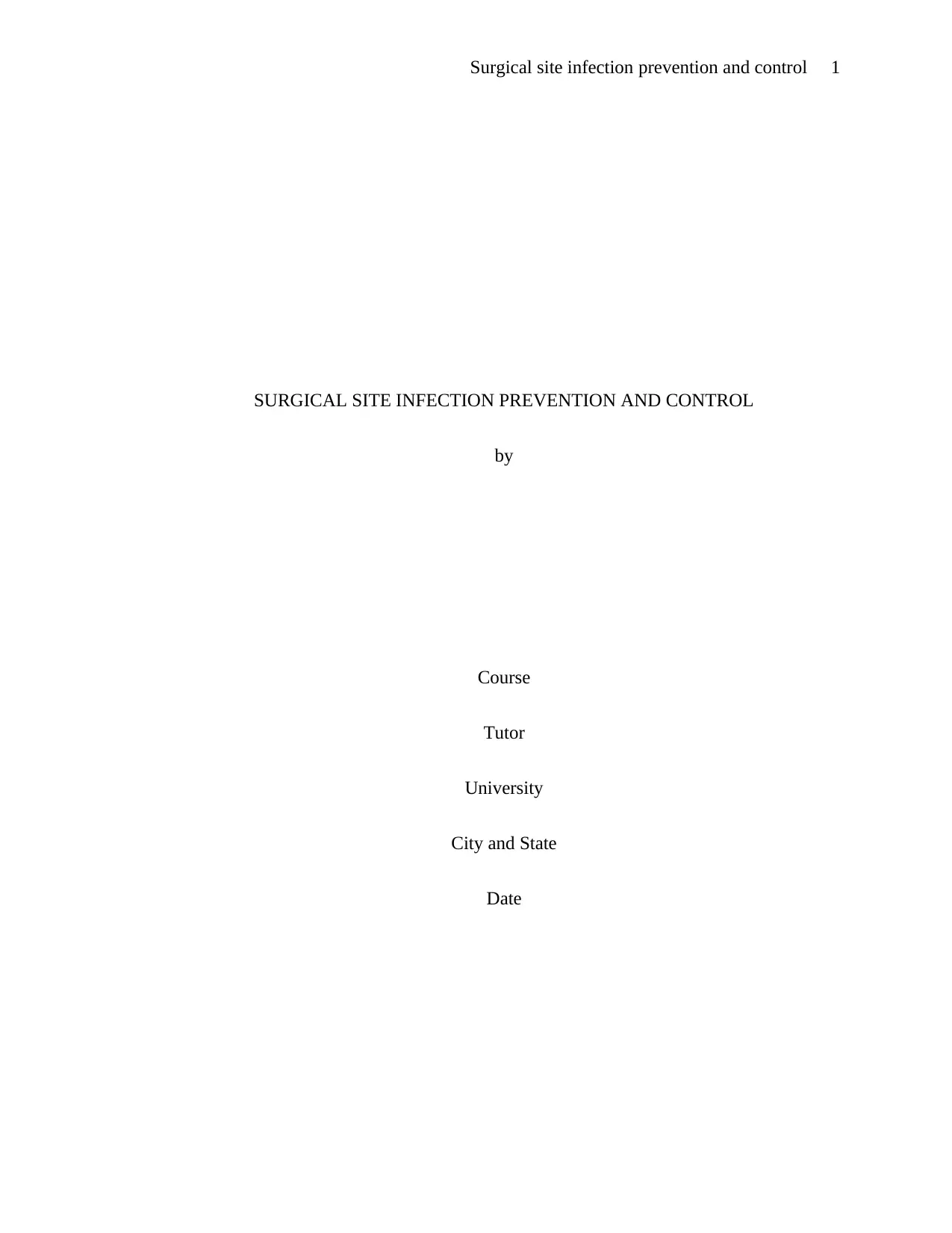
Surgical site infection prevention and control 1
SURGICAL SITE INFECTION PREVENTION AND CONTROL
by
Course
Tutor
University
City and State
Date
SURGICAL SITE INFECTION PREVENTION AND CONTROL
by
Course
Tutor
University
City and State
Date
Paraphrase This Document
Need a fresh take? Get an instant paraphrase of this document with our AI Paraphraser
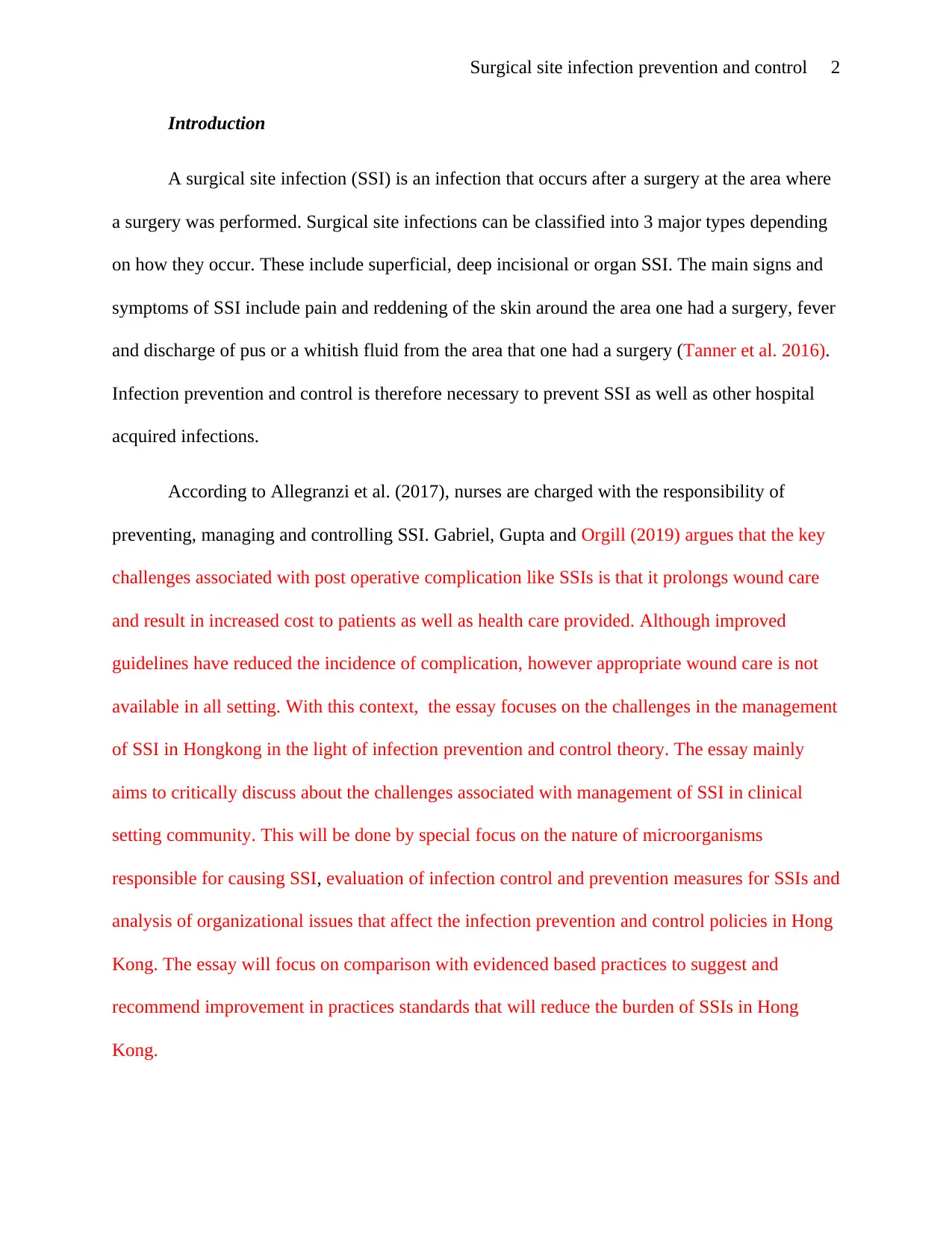
Surgical site infection prevention and control 2
Introduction
A surgical site infection (SSI) is an infection that occurs after a surgery at the area where
a surgery was performed. Surgical site infections can be classified into 3 major types depending
on how they occur. These include superficial, deep incisional or organ SSI. The main signs and
symptoms of SSI include pain and reddening of the skin around the area one had a surgery, fever
and discharge of pus or a whitish fluid from the area that one had a surgery (Tanner et al. 2016).
Infection prevention and control is therefore necessary to prevent SSI as well as other hospital
acquired infections.
According to Allegranzi et al. (2017), nurses are charged with the responsibility of
preventing, managing and controlling SSI. Gabriel, Gupta and Orgill (2019) argues that the key
challenges associated with post operative complication like SSIs is that it prolongs wound care
and result in increased cost to patients as well as health care provided. Although improved
guidelines have reduced the incidence of complication, however appropriate wound care is not
available in all setting. With this context, the essay focuses on the challenges in the management
of SSI in Hongkong in the light of infection prevention and control theory. The essay mainly
aims to critically discuss about the challenges associated with management of SSI in clinical
setting community. This will be done by special focus on the nature of microorganisms
responsible for causing SSI, evaluation of infection control and prevention measures for SSIs and
analysis of organizational issues that affect the infection prevention and control policies in Hong
Kong. The essay will focus on comparison with evidenced based practices to suggest and
recommend improvement in practices standards that will reduce the burden of SSIs in Hong
Kong.
Introduction
A surgical site infection (SSI) is an infection that occurs after a surgery at the area where
a surgery was performed. Surgical site infections can be classified into 3 major types depending
on how they occur. These include superficial, deep incisional or organ SSI. The main signs and
symptoms of SSI include pain and reddening of the skin around the area one had a surgery, fever
and discharge of pus or a whitish fluid from the area that one had a surgery (Tanner et al. 2016).
Infection prevention and control is therefore necessary to prevent SSI as well as other hospital
acquired infections.
According to Allegranzi et al. (2017), nurses are charged with the responsibility of
preventing, managing and controlling SSI. Gabriel, Gupta and Orgill (2019) argues that the key
challenges associated with post operative complication like SSIs is that it prolongs wound care
and result in increased cost to patients as well as health care provided. Although improved
guidelines have reduced the incidence of complication, however appropriate wound care is not
available in all setting. With this context, the essay focuses on the challenges in the management
of SSI in Hongkong in the light of infection prevention and control theory. The essay mainly
aims to critically discuss about the challenges associated with management of SSI in clinical
setting community. This will be done by special focus on the nature of microorganisms
responsible for causing SSI, evaluation of infection control and prevention measures for SSIs and
analysis of organizational issues that affect the infection prevention and control policies in Hong
Kong. The essay will focus on comparison with evidenced based practices to suggest and
recommend improvement in practices standards that will reduce the burden of SSIs in Hong
Kong.
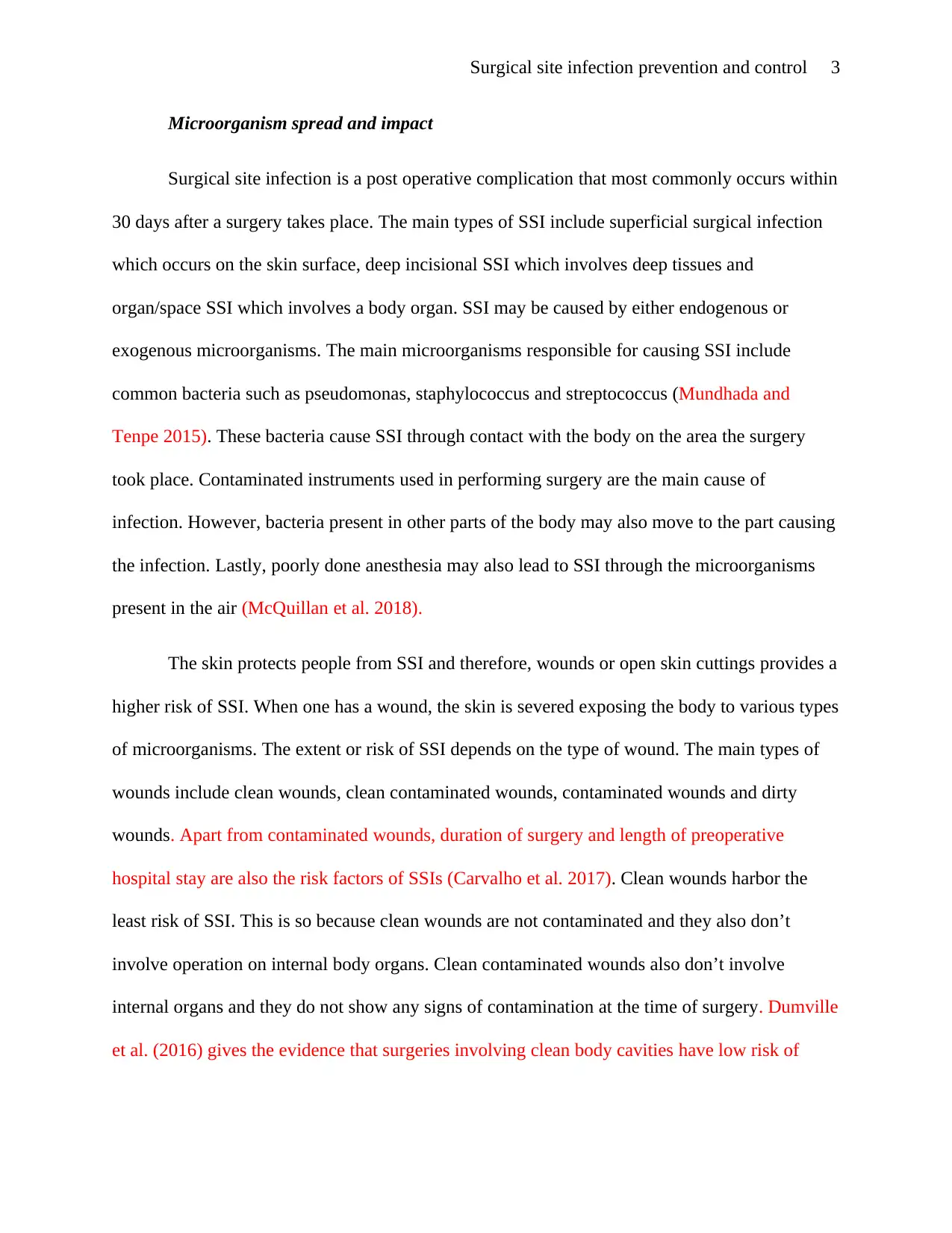
Surgical site infection prevention and control 3
Microorganism spread and impact
Surgical site infection is a post operative complication that most commonly occurs within
30 days after a surgery takes place. The main types of SSI include superficial surgical infection
which occurs on the skin surface, deep incisional SSI which involves deep tissues and
organ/space SSI which involves a body organ. SSI may be caused by either endogenous or
exogenous microorganisms. The main microorganisms responsible for causing SSI include
common bacteria such as pseudomonas, staphylococcus and streptococcus (Mundhada and
Tenpe 2015). These bacteria cause SSI through contact with the body on the area the surgery
took place. Contaminated instruments used in performing surgery are the main cause of
infection. However, bacteria present in other parts of the body may also move to the part causing
the infection. Lastly, poorly done anesthesia may also lead to SSI through the microorganisms
present in the air (McQuillan et al. 2018).
The skin protects people from SSI and therefore, wounds or open skin cuttings provides a
higher risk of SSI. When one has a wound, the skin is severed exposing the body to various types
of microorganisms. The extent or risk of SSI depends on the type of wound. The main types of
wounds include clean wounds, clean contaminated wounds, contaminated wounds and dirty
wounds. Apart from contaminated wounds, duration of surgery and length of preoperative
hospital stay are also the risk factors of SSIs (Carvalho et al. 2017). Clean wounds harbor the
least risk of SSI. This is so because clean wounds are not contaminated and they also don’t
involve operation on internal body organs. Clean contaminated wounds also don’t involve
internal organs and they do not show any signs of contamination at the time of surgery. Dumville
et al. (2016) gives the evidence that surgeries involving clean body cavities have low risk of
Microorganism spread and impact
Surgical site infection is a post operative complication that most commonly occurs within
30 days after a surgery takes place. The main types of SSI include superficial surgical infection
which occurs on the skin surface, deep incisional SSI which involves deep tissues and
organ/space SSI which involves a body organ. SSI may be caused by either endogenous or
exogenous microorganisms. The main microorganisms responsible for causing SSI include
common bacteria such as pseudomonas, staphylococcus and streptococcus (Mundhada and
Tenpe 2015). These bacteria cause SSI through contact with the body on the area the surgery
took place. Contaminated instruments used in performing surgery are the main cause of
infection. However, bacteria present in other parts of the body may also move to the part causing
the infection. Lastly, poorly done anesthesia may also lead to SSI through the microorganisms
present in the air (McQuillan et al. 2018).
The skin protects people from SSI and therefore, wounds or open skin cuttings provides a
higher risk of SSI. When one has a wound, the skin is severed exposing the body to various types
of microorganisms. The extent or risk of SSI depends on the type of wound. The main types of
wounds include clean wounds, clean contaminated wounds, contaminated wounds and dirty
wounds. Apart from contaminated wounds, duration of surgery and length of preoperative
hospital stay are also the risk factors of SSIs (Carvalho et al. 2017). Clean wounds harbor the
least risk of SSI. This is so because clean wounds are not contaminated and they also don’t
involve operation on internal body organs. Clean contaminated wounds also don’t involve
internal organs and they do not show any signs of contamination at the time of surgery. Dumville
et al. (2016) gives the evidence that surgeries involving clean body cavities have low risk of
⊘ This is a preview!⊘
Do you want full access?
Subscribe today to unlock all pages.

Trusted by 1+ million students worldwide
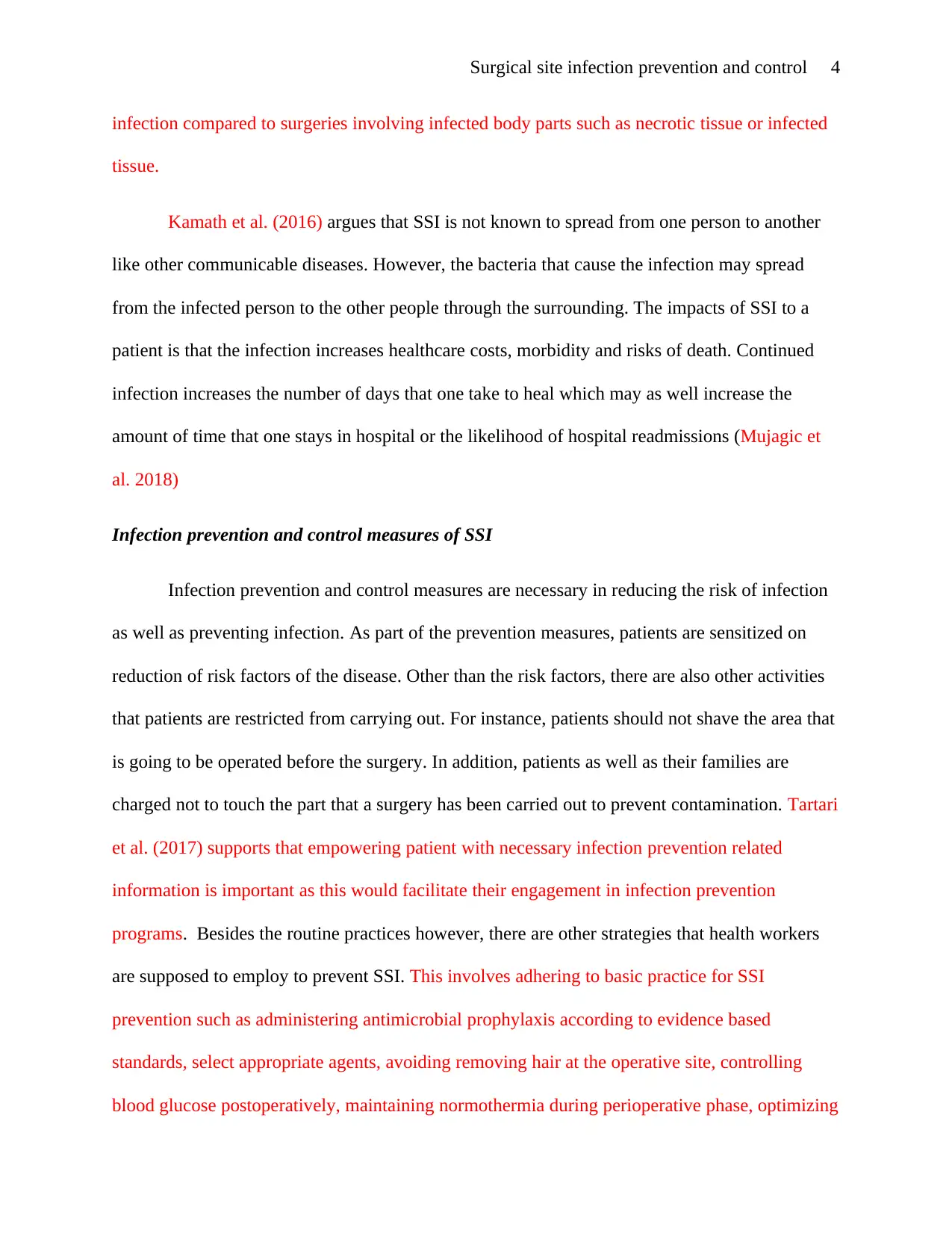
Surgical site infection prevention and control 4
infection compared to surgeries involving infected body parts such as necrotic tissue or infected
tissue.
Kamath et al. (2016) argues that SSI is not known to spread from one person to another
like other communicable diseases. However, the bacteria that cause the infection may spread
from the infected person to the other people through the surrounding. The impacts of SSI to a
patient is that the infection increases healthcare costs, morbidity and risks of death. Continued
infection increases the number of days that one take to heal which may as well increase the
amount of time that one stays in hospital or the likelihood of hospital readmissions (Mujagic et
al. 2018)
Infection prevention and control measures of SSI
Infection prevention and control measures are necessary in reducing the risk of infection
as well as preventing infection. As part of the prevention measures, patients are sensitized on
reduction of risk factors of the disease. Other than the risk factors, there are also other activities
that patients are restricted from carrying out. For instance, patients should not shave the area that
is going to be operated before the surgery. In addition, patients as well as their families are
charged not to touch the part that a surgery has been carried out to prevent contamination. Tartari
et al. (2017) supports that empowering patient with necessary infection prevention related
information is important as this would facilitate their engagement in infection prevention
programs. Besides the routine practices however, there are other strategies that health workers
are supposed to employ to prevent SSI. This involves adhering to basic practice for SSI
prevention such as administering antimicrobial prophylaxis according to evidence based
standards, select appropriate agents, avoiding removing hair at the operative site, controlling
blood glucose postoperatively, maintaining normothermia during perioperative phase, optimizing
infection compared to surgeries involving infected body parts such as necrotic tissue or infected
tissue.
Kamath et al. (2016) argues that SSI is not known to spread from one person to another
like other communicable diseases. However, the bacteria that cause the infection may spread
from the infected person to the other people through the surrounding. The impacts of SSI to a
patient is that the infection increases healthcare costs, morbidity and risks of death. Continued
infection increases the number of days that one take to heal which may as well increase the
amount of time that one stays in hospital or the likelihood of hospital readmissions (Mujagic et
al. 2018)
Infection prevention and control measures of SSI
Infection prevention and control measures are necessary in reducing the risk of infection
as well as preventing infection. As part of the prevention measures, patients are sensitized on
reduction of risk factors of the disease. Other than the risk factors, there are also other activities
that patients are restricted from carrying out. For instance, patients should not shave the area that
is going to be operated before the surgery. In addition, patients as well as their families are
charged not to touch the part that a surgery has been carried out to prevent contamination. Tartari
et al. (2017) supports that empowering patient with necessary infection prevention related
information is important as this would facilitate their engagement in infection prevention
programs. Besides the routine practices however, there are other strategies that health workers
are supposed to employ to prevent SSI. This involves adhering to basic practice for SSI
prevention such as administering antimicrobial prophylaxis according to evidence based
standards, select appropriate agents, avoiding removing hair at the operative site, controlling
blood glucose postoperatively, maintaining normothermia during perioperative phase, optimizing
Paraphrase This Document
Need a fresh take? Get an instant paraphrase of this document with our AI Paraphraser
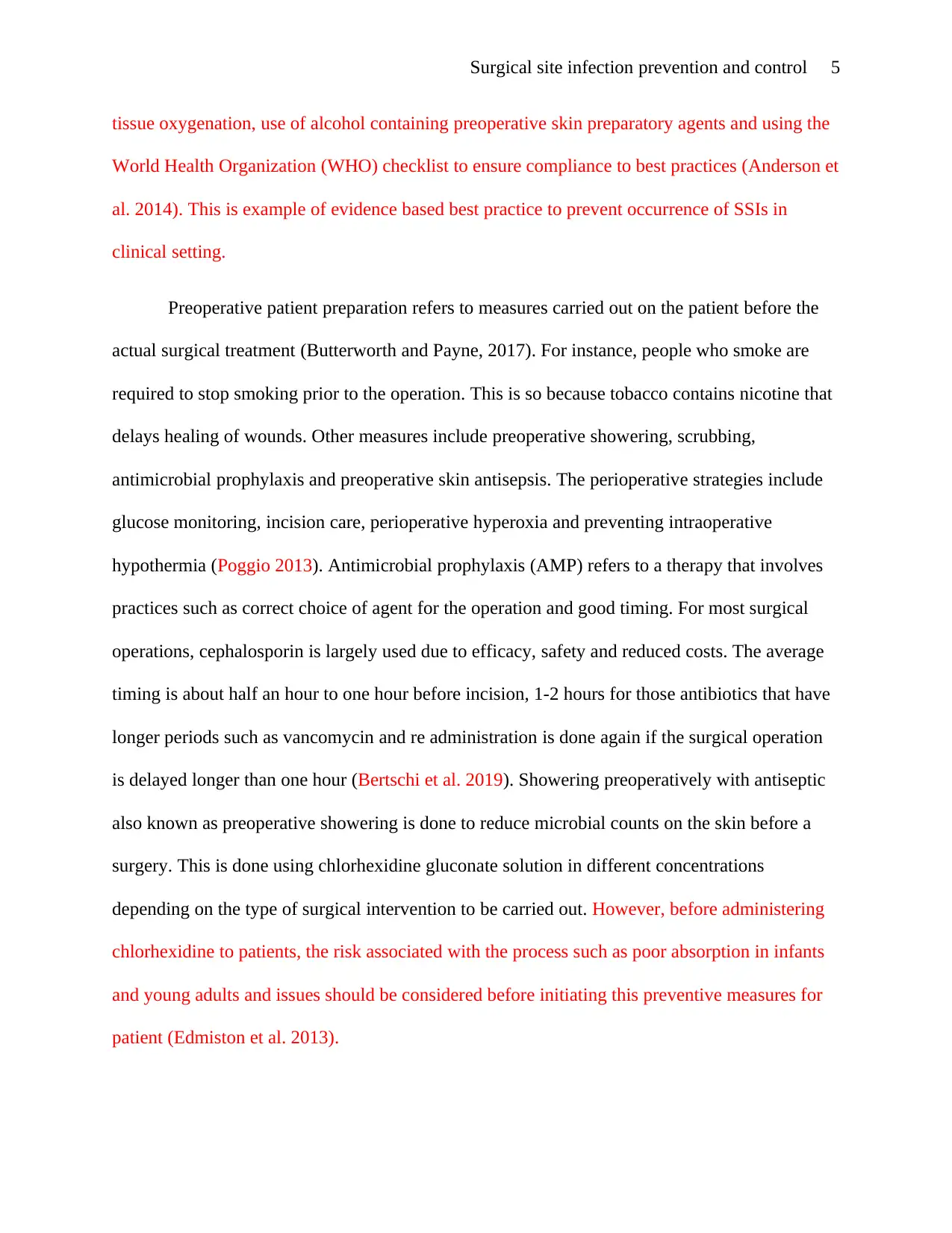
Surgical site infection prevention and control 5
tissue oxygenation, use of alcohol containing preoperative skin preparatory agents and using the
World Health Organization (WHO) checklist to ensure compliance to best practices (Anderson et
al. 2014). This is example of evidence based best practice to prevent occurrence of SSIs in
clinical setting.
Preoperative patient preparation refers to measures carried out on the patient before the
actual surgical treatment (Butterworth and Payne, 2017). For instance, people who smoke are
required to stop smoking prior to the operation. This is so because tobacco contains nicotine that
delays healing of wounds. Other measures include preoperative showering, scrubbing,
antimicrobial prophylaxis and preoperative skin antisepsis. The perioperative strategies include
glucose monitoring, incision care, perioperative hyperoxia and preventing intraoperative
hypothermia (Poggio 2013). Antimicrobial prophylaxis (AMP) refers to a therapy that involves
practices such as correct choice of agent for the operation and good timing. For most surgical
operations, cephalosporin is largely used due to efficacy, safety and reduced costs. The average
timing is about half an hour to one hour before incision, 1-2 hours for those antibiotics that have
longer periods such as vancomycin and re administration is done again if the surgical operation
is delayed longer than one hour (Bertschi et al. 2019). Showering preoperatively with antiseptic
also known as preoperative showering is done to reduce microbial counts on the skin before a
surgery. This is done using chlorhexidine gluconate solution in different concentrations
depending on the type of surgical intervention to be carried out. However, before administering
chlorhexidine to patients, the risk associated with the process such as poor absorption in infants
and young adults and issues should be considered before initiating this preventive measures for
patient (Edmiston et al. 2013).
tissue oxygenation, use of alcohol containing preoperative skin preparatory agents and using the
World Health Organization (WHO) checklist to ensure compliance to best practices (Anderson et
al. 2014). This is example of evidence based best practice to prevent occurrence of SSIs in
clinical setting.
Preoperative patient preparation refers to measures carried out on the patient before the
actual surgical treatment (Butterworth and Payne, 2017). For instance, people who smoke are
required to stop smoking prior to the operation. This is so because tobacco contains nicotine that
delays healing of wounds. Other measures include preoperative showering, scrubbing,
antimicrobial prophylaxis and preoperative skin antisepsis. The perioperative strategies include
glucose monitoring, incision care, perioperative hyperoxia and preventing intraoperative
hypothermia (Poggio 2013). Antimicrobial prophylaxis (AMP) refers to a therapy that involves
practices such as correct choice of agent for the operation and good timing. For most surgical
operations, cephalosporin is largely used due to efficacy, safety and reduced costs. The average
timing is about half an hour to one hour before incision, 1-2 hours for those antibiotics that have
longer periods such as vancomycin and re administration is done again if the surgical operation
is delayed longer than one hour (Bertschi et al. 2019). Showering preoperatively with antiseptic
also known as preoperative showering is done to reduce microbial counts on the skin before a
surgery. This is done using chlorhexidine gluconate solution in different concentrations
depending on the type of surgical intervention to be carried out. However, before administering
chlorhexidine to patients, the risk associated with the process such as poor absorption in infants
and young adults and issues should be considered before initiating this preventive measures for
patient (Edmiston et al. 2013).
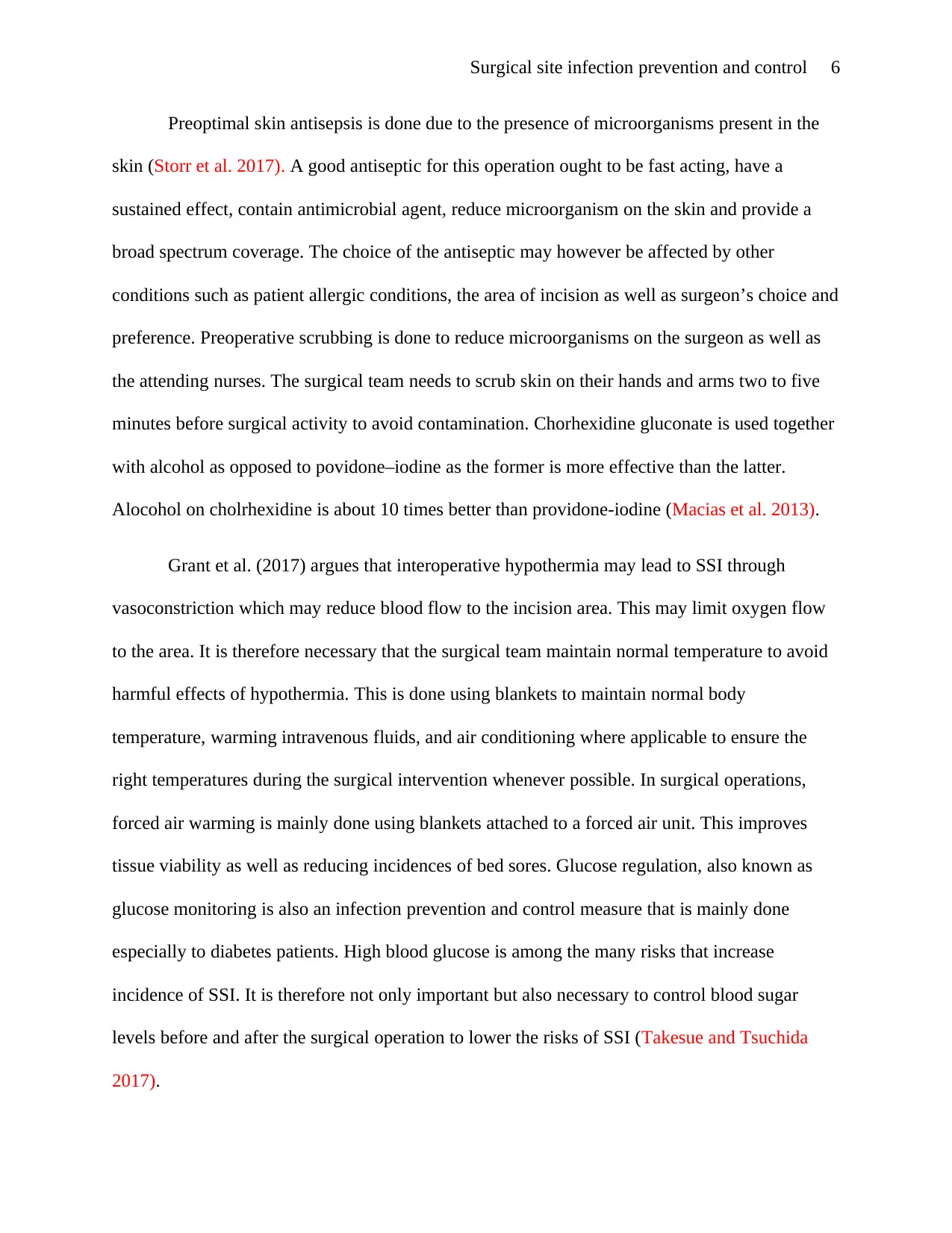
Surgical site infection prevention and control 6
Preoptimal skin antisepsis is done due to the presence of microorganisms present in the
skin (Storr et al. 2017). A good antiseptic for this operation ought to be fast acting, have a
sustained effect, contain antimicrobial agent, reduce microorganism on the skin and provide a
broad spectrum coverage. The choice of the antiseptic may however be affected by other
conditions such as patient allergic conditions, the area of incision as well as surgeon’s choice and
preference. Preoperative scrubbing is done to reduce microorganisms on the surgeon as well as
the attending nurses. The surgical team needs to scrub skin on their hands and arms two to five
minutes before surgical activity to avoid contamination. Chorhexidine gluconate is used together
with alcohol as opposed to povidone–iodine as the former is more effective than the latter.
Alocohol on cholrhexidine is about 10 times better than providone-iodine (Macias et al. 2013).
Grant et al. (2017) argues that interoperative hypothermia may lead to SSI through
vasoconstriction which may reduce blood flow to the incision area. This may limit oxygen flow
to the area. It is therefore necessary that the surgical team maintain normal temperature to avoid
harmful effects of hypothermia. This is done using blankets to maintain normal body
temperature, warming intravenous fluids, and air conditioning where applicable to ensure the
right temperatures during the surgical intervention whenever possible. In surgical operations,
forced air warming is mainly done using blankets attached to a forced air unit. This improves
tissue viability as well as reducing incidences of bed sores. Glucose regulation, also known as
glucose monitoring is also an infection prevention and control measure that is mainly done
especially to diabetes patients. High blood glucose is among the many risks that increase
incidence of SSI. It is therefore not only important but also necessary to control blood sugar
levels before and after the surgical operation to lower the risks of SSI (Takesue and Tsuchida
2017).
Preoptimal skin antisepsis is done due to the presence of microorganisms present in the
skin (Storr et al. 2017). A good antiseptic for this operation ought to be fast acting, have a
sustained effect, contain antimicrobial agent, reduce microorganism on the skin and provide a
broad spectrum coverage. The choice of the antiseptic may however be affected by other
conditions such as patient allergic conditions, the area of incision as well as surgeon’s choice and
preference. Preoperative scrubbing is done to reduce microorganisms on the surgeon as well as
the attending nurses. The surgical team needs to scrub skin on their hands and arms two to five
minutes before surgical activity to avoid contamination. Chorhexidine gluconate is used together
with alcohol as opposed to povidone–iodine as the former is more effective than the latter.
Alocohol on cholrhexidine is about 10 times better than providone-iodine (Macias et al. 2013).
Grant et al. (2017) argues that interoperative hypothermia may lead to SSI through
vasoconstriction which may reduce blood flow to the incision area. This may limit oxygen flow
to the area. It is therefore necessary that the surgical team maintain normal temperature to avoid
harmful effects of hypothermia. This is done using blankets to maintain normal body
temperature, warming intravenous fluids, and air conditioning where applicable to ensure the
right temperatures during the surgical intervention whenever possible. In surgical operations,
forced air warming is mainly done using blankets attached to a forced air unit. This improves
tissue viability as well as reducing incidences of bed sores. Glucose regulation, also known as
glucose monitoring is also an infection prevention and control measure that is mainly done
especially to diabetes patients. High blood glucose is among the many risks that increase
incidence of SSI. It is therefore not only important but also necessary to control blood sugar
levels before and after the surgical operation to lower the risks of SSI (Takesue and Tsuchida
2017).
⊘ This is a preview!⊘
Do you want full access?
Subscribe today to unlock all pages.

Trusted by 1+ million students worldwide
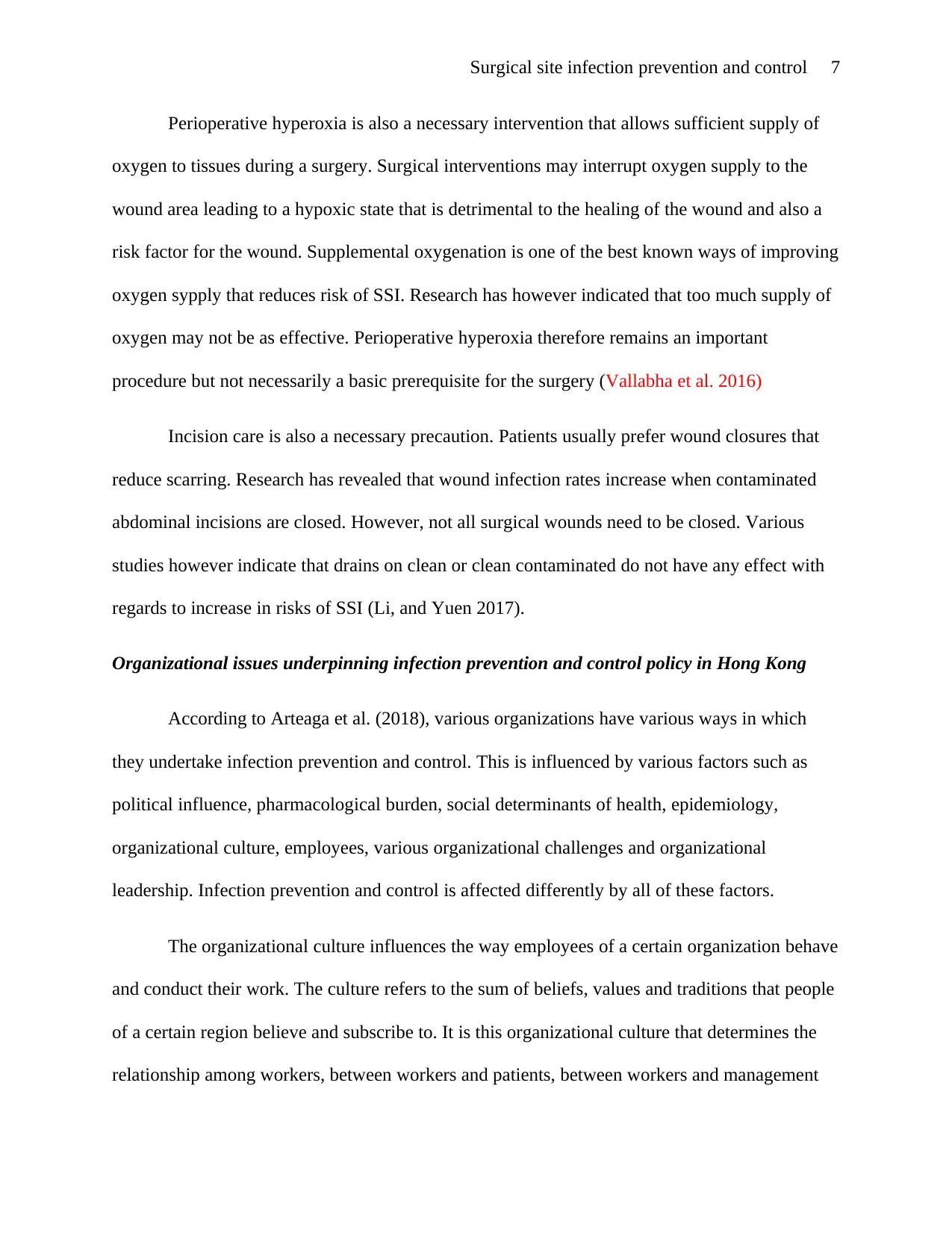
Surgical site infection prevention and control 7
Perioperative hyperoxia is also a necessary intervention that allows sufficient supply of
oxygen to tissues during a surgery. Surgical interventions may interrupt oxygen supply to the
wound area leading to a hypoxic state that is detrimental to the healing of the wound and also a
risk factor for the wound. Supplemental oxygenation is one of the best known ways of improving
oxygen sypply that reduces risk of SSI. Research has however indicated that too much supply of
oxygen may not be as effective. Perioperative hyperoxia therefore remains an important
procedure but not necessarily a basic prerequisite for the surgery (Vallabha et al. 2016)
Incision care is also a necessary precaution. Patients usually prefer wound closures that
reduce scarring. Research has revealed that wound infection rates increase when contaminated
abdominal incisions are closed. However, not all surgical wounds need to be closed. Various
studies however indicate that drains on clean or clean contaminated do not have any effect with
regards to increase in risks of SSI (Li, and Yuen 2017).
Organizational issues underpinning infection prevention and control policy in Hong Kong
According to Arteaga et al. (2018), various organizations have various ways in which
they undertake infection prevention and control. This is influenced by various factors such as
political influence, pharmacological burden, social determinants of health, epidemiology,
organizational culture, employees, various organizational challenges and organizational
leadership. Infection prevention and control is affected differently by all of these factors.
The organizational culture influences the way employees of a certain organization behave
and conduct their work. The culture refers to the sum of beliefs, values and traditions that people
of a certain region believe and subscribe to. It is this organizational culture that determines the
relationship among workers, between workers and patients, between workers and management
Perioperative hyperoxia is also a necessary intervention that allows sufficient supply of
oxygen to tissues during a surgery. Surgical interventions may interrupt oxygen supply to the
wound area leading to a hypoxic state that is detrimental to the healing of the wound and also a
risk factor for the wound. Supplemental oxygenation is one of the best known ways of improving
oxygen sypply that reduces risk of SSI. Research has however indicated that too much supply of
oxygen may not be as effective. Perioperative hyperoxia therefore remains an important
procedure but not necessarily a basic prerequisite for the surgery (Vallabha et al. 2016)
Incision care is also a necessary precaution. Patients usually prefer wound closures that
reduce scarring. Research has revealed that wound infection rates increase when contaminated
abdominal incisions are closed. However, not all surgical wounds need to be closed. Various
studies however indicate that drains on clean or clean contaminated do not have any effect with
regards to increase in risks of SSI (Li, and Yuen 2017).
Organizational issues underpinning infection prevention and control policy in Hong Kong
According to Arteaga et al. (2018), various organizations have various ways in which
they undertake infection prevention and control. This is influenced by various factors such as
political influence, pharmacological burden, social determinants of health, epidemiology,
organizational culture, employees, various organizational challenges and organizational
leadership. Infection prevention and control is affected differently by all of these factors.
The organizational culture influences the way employees of a certain organization behave
and conduct their work. The culture refers to the sum of beliefs, values and traditions that people
of a certain region believe and subscribe to. It is this organizational culture that determines the
relationship among workers, between workers and patients, between workers and management
Paraphrase This Document
Need a fresh take? Get an instant paraphrase of this document with our AI Paraphraser
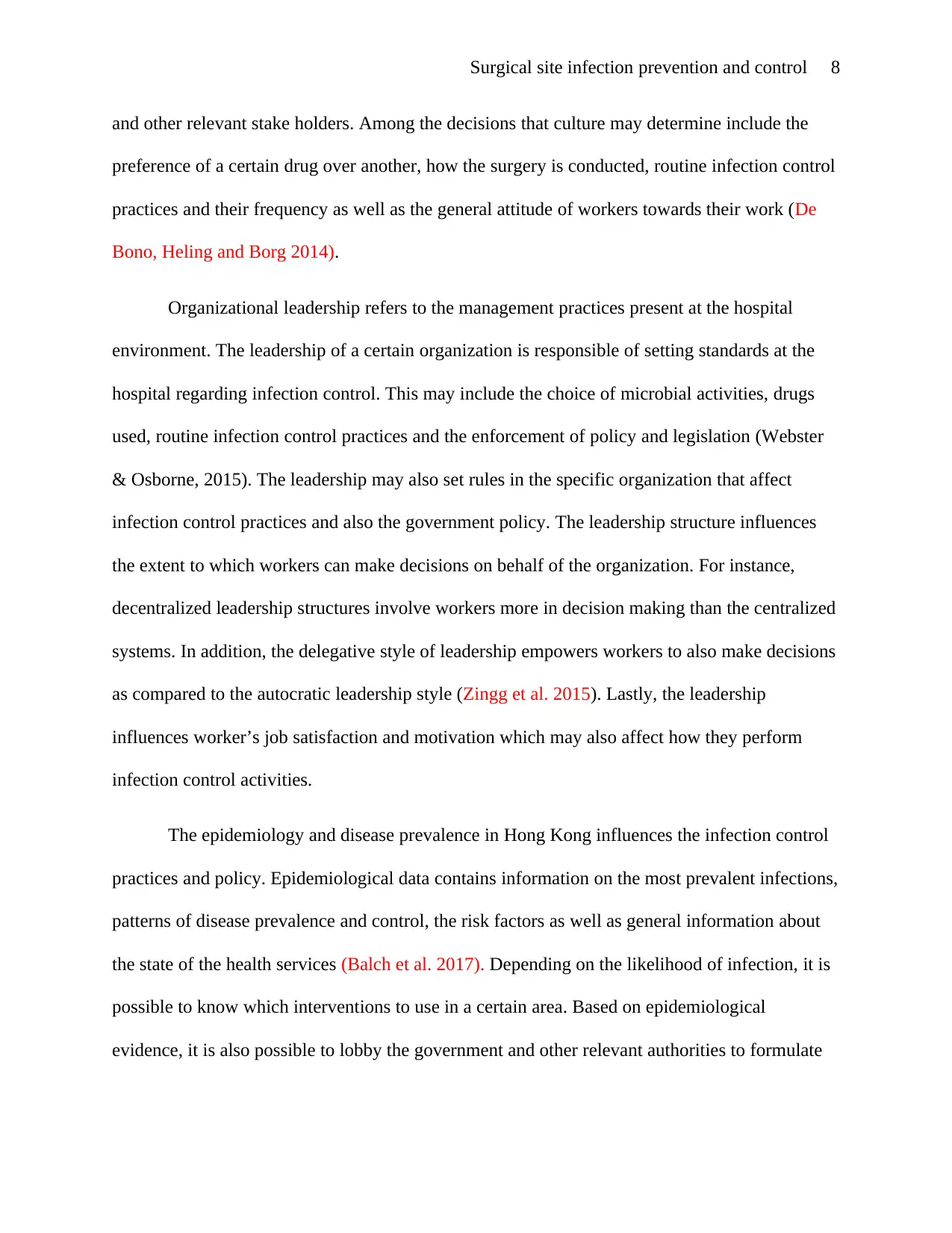
Surgical site infection prevention and control 8
and other relevant stake holders. Among the decisions that culture may determine include the
preference of a certain drug over another, how the surgery is conducted, routine infection control
practices and their frequency as well as the general attitude of workers towards their work (De
Bono, Heling and Borg 2014).
Organizational leadership refers to the management practices present at the hospital
environment. The leadership of a certain organization is responsible of setting standards at the
hospital regarding infection control. This may include the choice of microbial activities, drugs
used, routine infection control practices and the enforcement of policy and legislation (Webster
& Osborne, 2015). The leadership may also set rules in the specific organization that affect
infection control practices and also the government policy. The leadership structure influences
the extent to which workers can make decisions on behalf of the organization. For instance,
decentralized leadership structures involve workers more in decision making than the centralized
systems. In addition, the delegative style of leadership empowers workers to also make decisions
as compared to the autocratic leadership style (Zingg et al. 2015). Lastly, the leadership
influences worker’s job satisfaction and motivation which may also affect how they perform
infection control activities.
The epidemiology and disease prevalence in Hong Kong influences the infection control
practices and policy. Epidemiological data contains information on the most prevalent infections,
patterns of disease prevalence and control, the risk factors as well as general information about
the state of the health services (Balch et al. 2017). Depending on the likelihood of infection, it is
possible to know which interventions to use in a certain area. Based on epidemiological
evidence, it is also possible to lobby the government and other relevant authorities to formulate
and other relevant stake holders. Among the decisions that culture may determine include the
preference of a certain drug over another, how the surgery is conducted, routine infection control
practices and their frequency as well as the general attitude of workers towards their work (De
Bono, Heling and Borg 2014).
Organizational leadership refers to the management practices present at the hospital
environment. The leadership of a certain organization is responsible of setting standards at the
hospital regarding infection control. This may include the choice of microbial activities, drugs
used, routine infection control practices and the enforcement of policy and legislation (Webster
& Osborne, 2015). The leadership may also set rules in the specific organization that affect
infection control practices and also the government policy. The leadership structure influences
the extent to which workers can make decisions on behalf of the organization. For instance,
decentralized leadership structures involve workers more in decision making than the centralized
systems. In addition, the delegative style of leadership empowers workers to also make decisions
as compared to the autocratic leadership style (Zingg et al. 2015). Lastly, the leadership
influences worker’s job satisfaction and motivation which may also affect how they perform
infection control activities.
The epidemiology and disease prevalence in Hong Kong influences the infection control
practices and policy. Epidemiological data contains information on the most prevalent infections,
patterns of disease prevalence and control, the risk factors as well as general information about
the state of the health services (Balch et al. 2017). Depending on the likelihood of infection, it is
possible to know which interventions to use in a certain area. Based on epidemiological
evidence, it is also possible to lobby the government and other relevant authorities to formulate
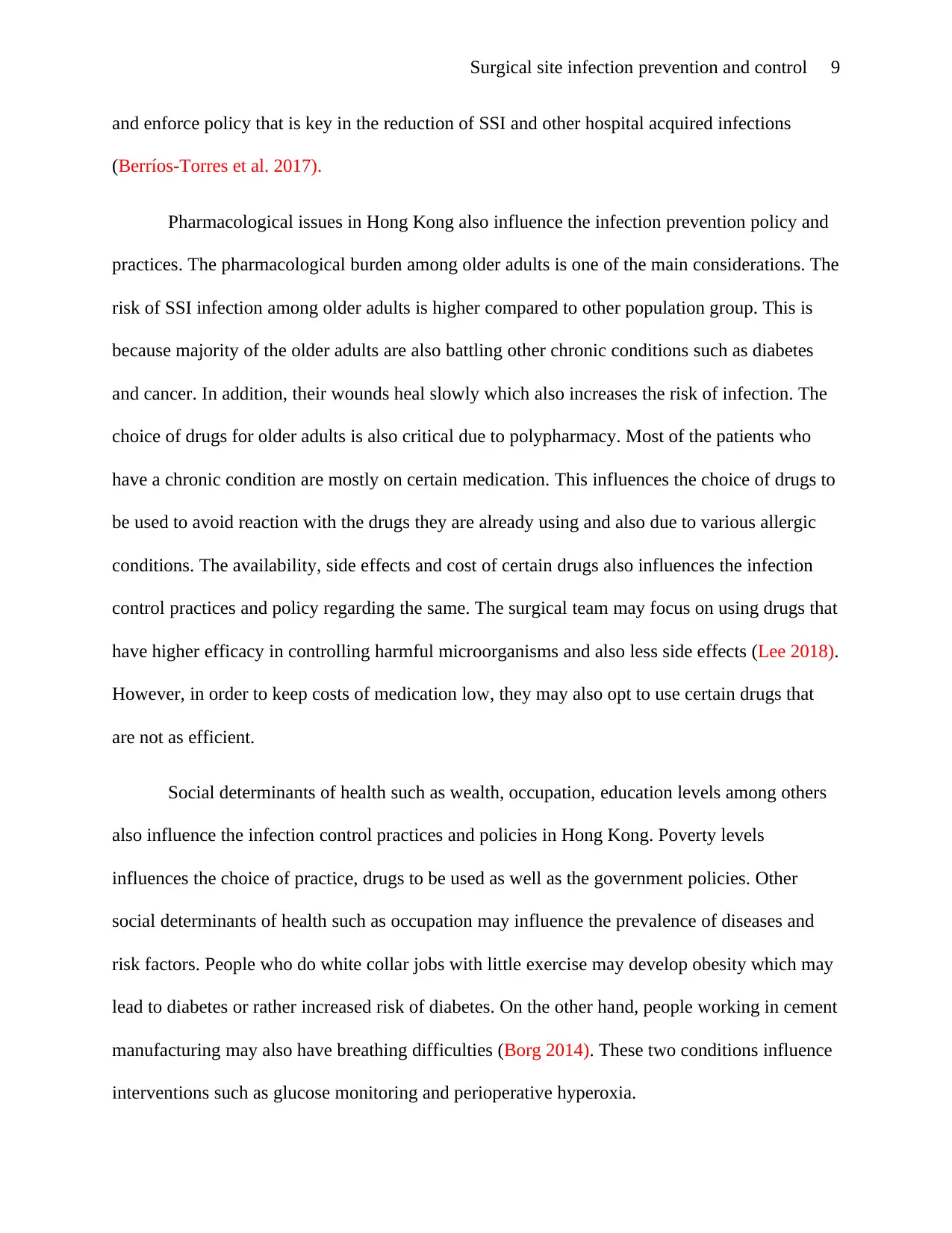
Surgical site infection prevention and control 9
and enforce policy that is key in the reduction of SSI and other hospital acquired infections
(Berríos-Torres et al. 2017).
Pharmacological issues in Hong Kong also influence the infection prevention policy and
practices. The pharmacological burden among older adults is one of the main considerations. The
risk of SSI infection among older adults is higher compared to other population group. This is
because majority of the older adults are also battling other chronic conditions such as diabetes
and cancer. In addition, their wounds heal slowly which also increases the risk of infection. The
choice of drugs for older adults is also critical due to polypharmacy. Most of the patients who
have a chronic condition are mostly on certain medication. This influences the choice of drugs to
be used to avoid reaction with the drugs they are already using and also due to various allergic
conditions. The availability, side effects and cost of certain drugs also influences the infection
control practices and policy regarding the same. The surgical team may focus on using drugs that
have higher efficacy in controlling harmful microorganisms and also less side effects (Lee 2018).
However, in order to keep costs of medication low, they may also opt to use certain drugs that
are not as efficient.
Social determinants of health such as wealth, occupation, education levels among others
also influence the infection control practices and policies in Hong Kong. Poverty levels
influences the choice of practice, drugs to be used as well as the government policies. Other
social determinants of health such as occupation may influence the prevalence of diseases and
risk factors. People who do white collar jobs with little exercise may develop obesity which may
lead to diabetes or rather increased risk of diabetes. On the other hand, people working in cement
manufacturing may also have breathing difficulties (Borg 2014). These two conditions influence
interventions such as glucose monitoring and perioperative hyperoxia.
and enforce policy that is key in the reduction of SSI and other hospital acquired infections
(Berríos-Torres et al. 2017).
Pharmacological issues in Hong Kong also influence the infection prevention policy and
practices. The pharmacological burden among older adults is one of the main considerations. The
risk of SSI infection among older adults is higher compared to other population group. This is
because majority of the older adults are also battling other chronic conditions such as diabetes
and cancer. In addition, their wounds heal slowly which also increases the risk of infection. The
choice of drugs for older adults is also critical due to polypharmacy. Most of the patients who
have a chronic condition are mostly on certain medication. This influences the choice of drugs to
be used to avoid reaction with the drugs they are already using and also due to various allergic
conditions. The availability, side effects and cost of certain drugs also influences the infection
control practices and policy regarding the same. The surgical team may focus on using drugs that
have higher efficacy in controlling harmful microorganisms and also less side effects (Lee 2018).
However, in order to keep costs of medication low, they may also opt to use certain drugs that
are not as efficient.
Social determinants of health such as wealth, occupation, education levels among others
also influence the infection control practices and policies in Hong Kong. Poverty levels
influences the choice of practice, drugs to be used as well as the government policies. Other
social determinants of health such as occupation may influence the prevalence of diseases and
risk factors. People who do white collar jobs with little exercise may develop obesity which may
lead to diabetes or rather increased risk of diabetes. On the other hand, people working in cement
manufacturing may also have breathing difficulties (Borg 2014). These two conditions influence
interventions such as glucose monitoring and perioperative hyperoxia.
⊘ This is a preview!⊘
Do you want full access?
Subscribe today to unlock all pages.

Trusted by 1+ million students worldwide
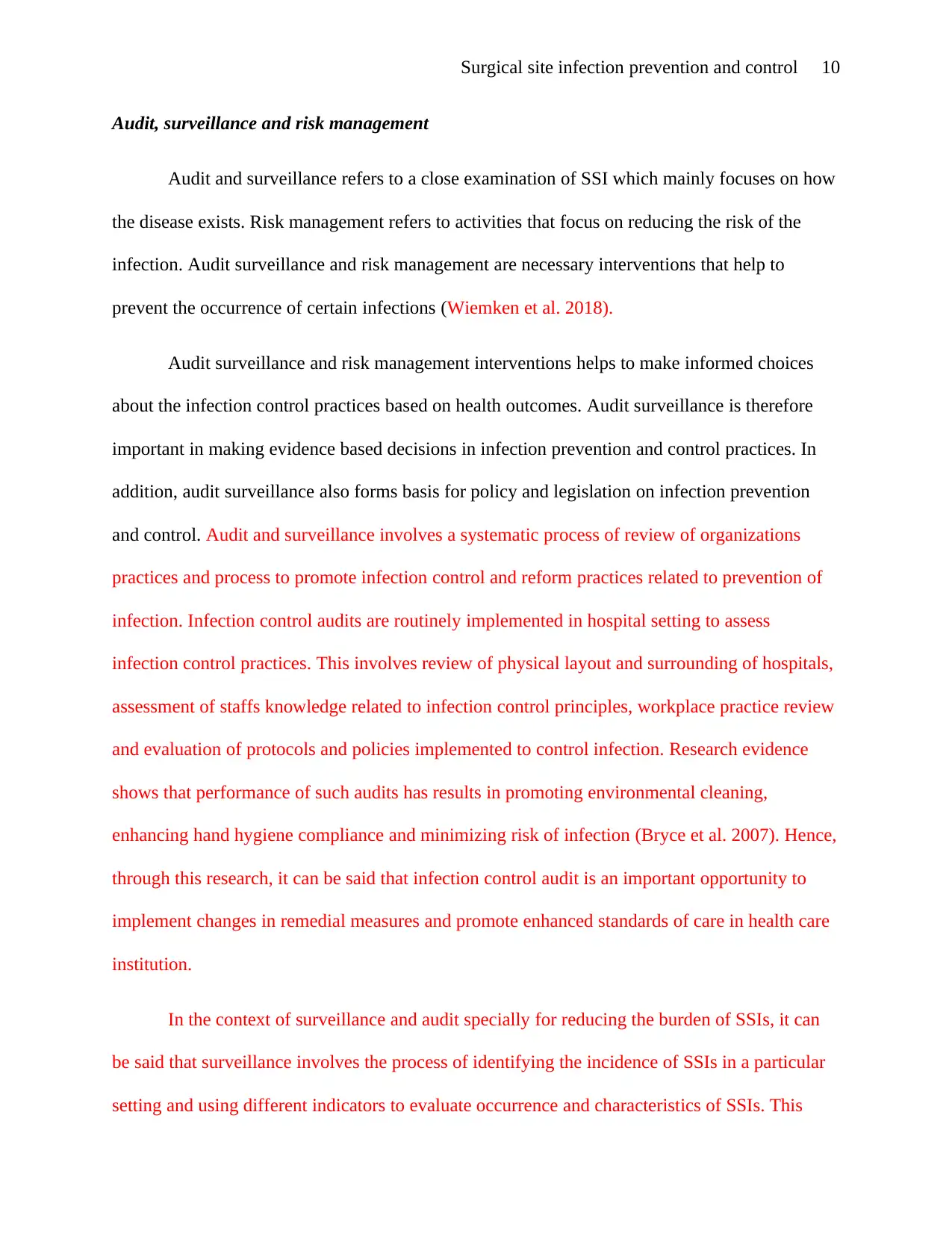
Surgical site infection prevention and control 10
Audit, surveillance and risk management
Audit and surveillance refers to a close examination of SSI which mainly focuses on how
the disease exists. Risk management refers to activities that focus on reducing the risk of the
infection. Audit surveillance and risk management are necessary interventions that help to
prevent the occurrence of certain infections (Wiemken et al. 2018).
Audit surveillance and risk management interventions helps to make informed choices
about the infection control practices based on health outcomes. Audit surveillance is therefore
important in making evidence based decisions in infection prevention and control practices. In
addition, audit surveillance also forms basis for policy and legislation on infection prevention
and control. Audit and surveillance involves a systematic process of review of organizations
practices and process to promote infection control and reform practices related to prevention of
infection. Infection control audits are routinely implemented in hospital setting to assess
infection control practices. This involves review of physical layout and surrounding of hospitals,
assessment of staffs knowledge related to infection control principles, workplace practice review
and evaluation of protocols and policies implemented to control infection. Research evidence
shows that performance of such audits has results in promoting environmental cleaning,
enhancing hand hygiene compliance and minimizing risk of infection (Bryce et al. 2007). Hence,
through this research, it can be said that infection control audit is an important opportunity to
implement changes in remedial measures and promote enhanced standards of care in health care
institution.
In the context of surveillance and audit specially for reducing the burden of SSIs, it can
be said that surveillance involves the process of identifying the incidence of SSIs in a particular
setting and using different indicators to evaluate occurrence and characteristics of SSIs. This
Audit, surveillance and risk management
Audit and surveillance refers to a close examination of SSI which mainly focuses on how
the disease exists. Risk management refers to activities that focus on reducing the risk of the
infection. Audit surveillance and risk management are necessary interventions that help to
prevent the occurrence of certain infections (Wiemken et al. 2018).
Audit surveillance and risk management interventions helps to make informed choices
about the infection control practices based on health outcomes. Audit surveillance is therefore
important in making evidence based decisions in infection prevention and control practices. In
addition, audit surveillance also forms basis for policy and legislation on infection prevention
and control. Audit and surveillance involves a systematic process of review of organizations
practices and process to promote infection control and reform practices related to prevention of
infection. Infection control audits are routinely implemented in hospital setting to assess
infection control practices. This involves review of physical layout and surrounding of hospitals,
assessment of staffs knowledge related to infection control principles, workplace practice review
and evaluation of protocols and policies implemented to control infection. Research evidence
shows that performance of such audits has results in promoting environmental cleaning,
enhancing hand hygiene compliance and minimizing risk of infection (Bryce et al. 2007). Hence,
through this research, it can be said that infection control audit is an important opportunity to
implement changes in remedial measures and promote enhanced standards of care in health care
institution.
In the context of surveillance and audit specially for reducing the burden of SSIs, it can
be said that surveillance involves the process of identifying the incidence of SSIs in a particular
setting and using different indicators to evaluate occurrence and characteristics of SSIs. This
Paraphrase This Document
Need a fresh take? Get an instant paraphrase of this document with our AI Paraphraser
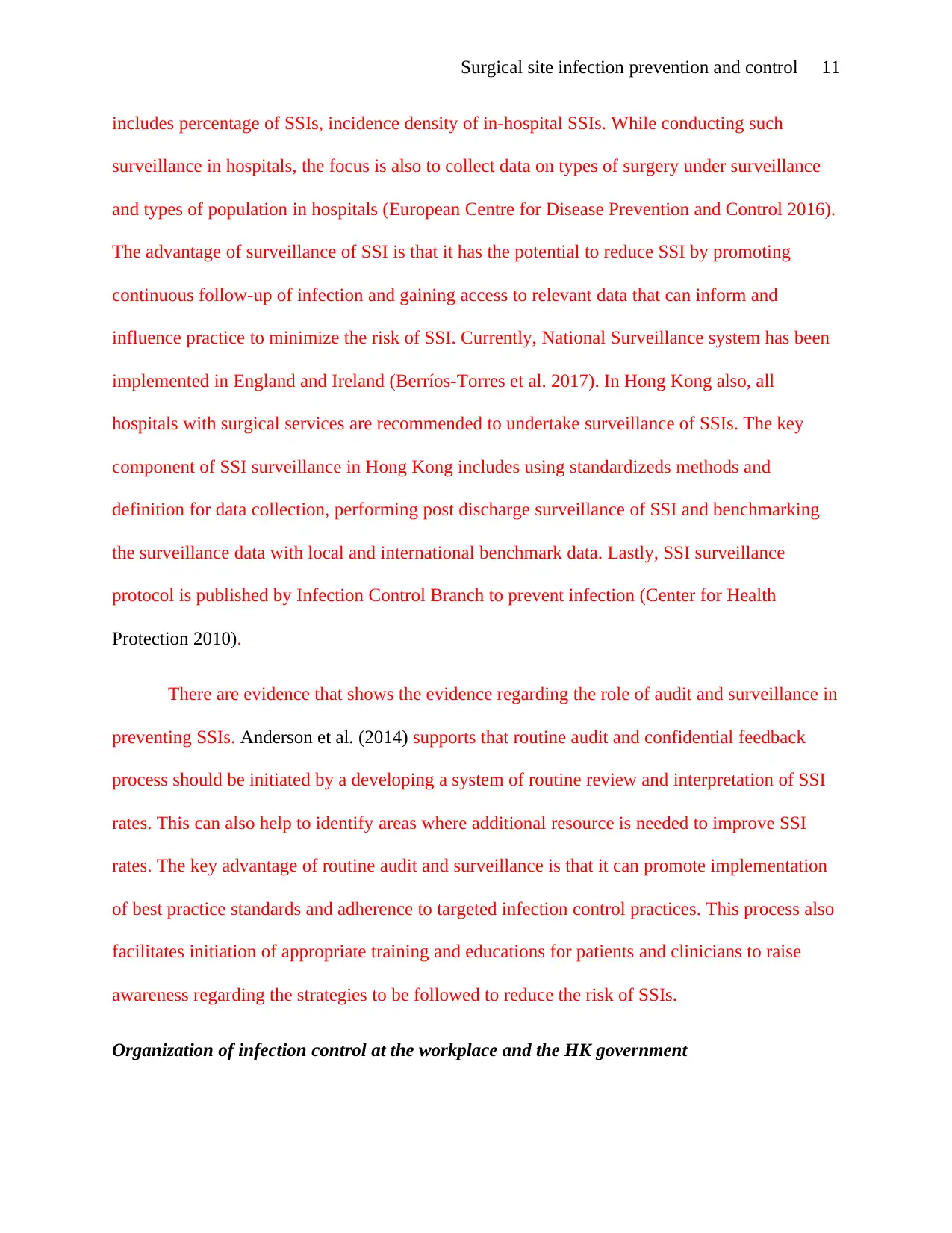
Surgical site infection prevention and control 11
includes percentage of SSIs, incidence density of in-hospital SSIs. While conducting such
surveillance in hospitals, the focus is also to collect data on types of surgery under surveillance
and types of population in hospitals (European Centre for Disease Prevention and Control 2016).
The advantage of surveillance of SSI is that it has the potential to reduce SSI by promoting
continuous follow-up of infection and gaining access to relevant data that can inform and
influence practice to minimize the risk of SSI. Currently, National Surveillance system has been
implemented in England and Ireland (Berríos-Torres et al. 2017). In Hong Kong also, all
hospitals with surgical services are recommended to undertake surveillance of SSIs. The key
component of SSI surveillance in Hong Kong includes using standardizeds methods and
definition for data collection, performing post discharge surveillance of SSI and benchmarking
the surveillance data with local and international benchmark data. Lastly, SSI surveillance
protocol is published by Infection Control Branch to prevent infection (Center for Health
Protection 2010).
There are evidence that shows the evidence regarding the role of audit and surveillance in
preventing SSIs. Anderson et al. (2014) supports that routine audit and confidential feedback
process should be initiated by a developing a system of routine review and interpretation of SSI
rates. This can also help to identify areas where additional resource is needed to improve SSI
rates. The key advantage of routine audit and surveillance is that it can promote implementation
of best practice standards and adherence to targeted infection control practices. This process also
facilitates initiation of appropriate training and educations for patients and clinicians to raise
awareness regarding the strategies to be followed to reduce the risk of SSIs.
Organization of infection control at the workplace and the HK government
includes percentage of SSIs, incidence density of in-hospital SSIs. While conducting such
surveillance in hospitals, the focus is also to collect data on types of surgery under surveillance
and types of population in hospitals (European Centre for Disease Prevention and Control 2016).
The advantage of surveillance of SSI is that it has the potential to reduce SSI by promoting
continuous follow-up of infection and gaining access to relevant data that can inform and
influence practice to minimize the risk of SSI. Currently, National Surveillance system has been
implemented in England and Ireland (Berríos-Torres et al. 2017). In Hong Kong also, all
hospitals with surgical services are recommended to undertake surveillance of SSIs. The key
component of SSI surveillance in Hong Kong includes using standardizeds methods and
definition for data collection, performing post discharge surveillance of SSI and benchmarking
the surveillance data with local and international benchmark data. Lastly, SSI surveillance
protocol is published by Infection Control Branch to prevent infection (Center for Health
Protection 2010).
There are evidence that shows the evidence regarding the role of audit and surveillance in
preventing SSIs. Anderson et al. (2014) supports that routine audit and confidential feedback
process should be initiated by a developing a system of routine review and interpretation of SSI
rates. This can also help to identify areas where additional resource is needed to improve SSI
rates. The key advantage of routine audit and surveillance is that it can promote implementation
of best practice standards and adherence to targeted infection control practices. This process also
facilitates initiation of appropriate training and educations for patients and clinicians to raise
awareness regarding the strategies to be followed to reduce the risk of SSIs.
Organization of infection control at the workplace and the HK government
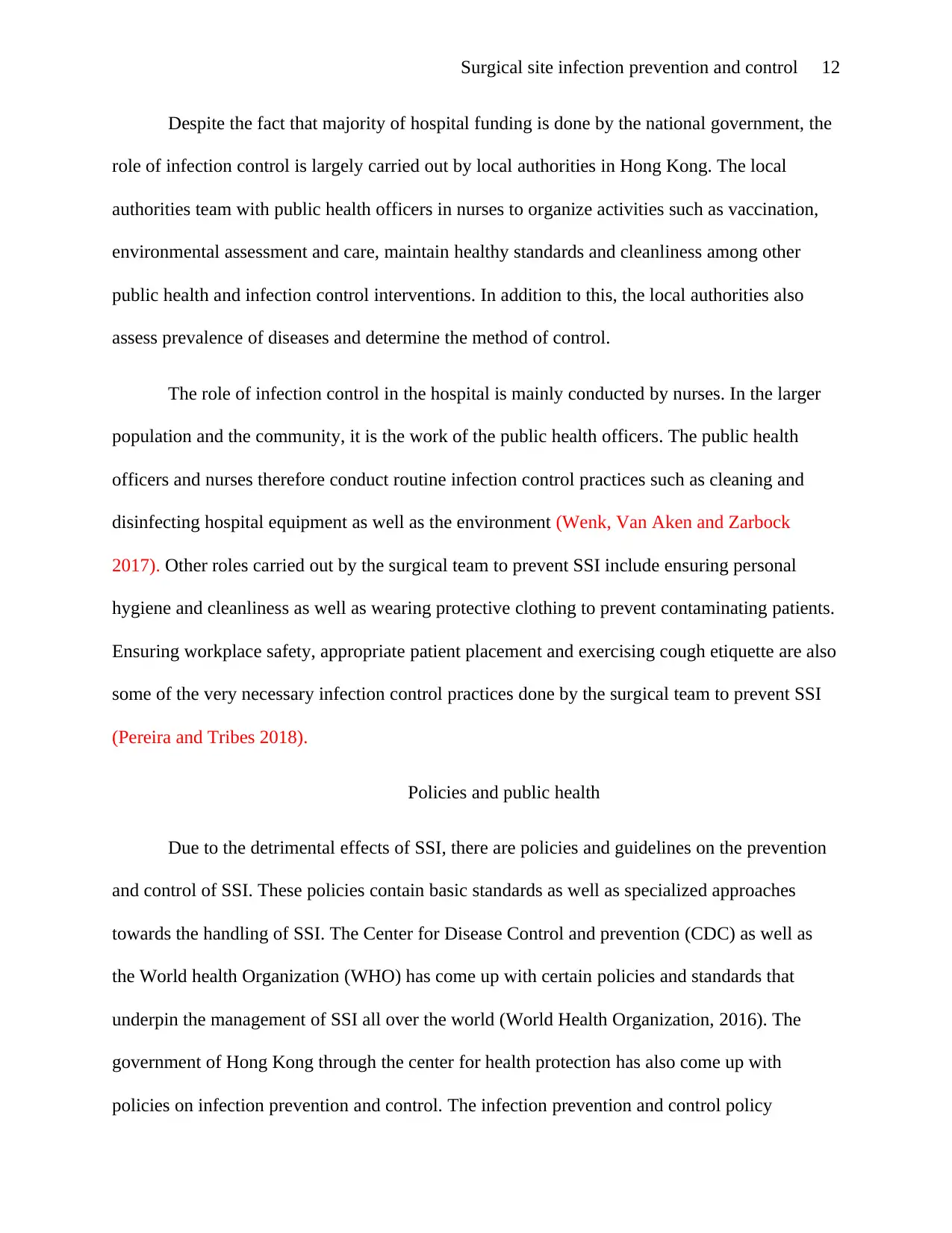
Surgical site infection prevention and control 12
Despite the fact that majority of hospital funding is done by the national government, the
role of infection control is largely carried out by local authorities in Hong Kong. The local
authorities team with public health officers in nurses to organize activities such as vaccination,
environmental assessment and care, maintain healthy standards and cleanliness among other
public health and infection control interventions. In addition to this, the local authorities also
assess prevalence of diseases and determine the method of control.
The role of infection control in the hospital is mainly conducted by nurses. In the larger
population and the community, it is the work of the public health officers. The public health
officers and nurses therefore conduct routine infection control practices such as cleaning and
disinfecting hospital equipment as well as the environment (Wenk, Van Aken and Zarbock
2017). Other roles carried out by the surgical team to prevent SSI include ensuring personal
hygiene and cleanliness as well as wearing protective clothing to prevent contaminating patients.
Ensuring workplace safety, appropriate patient placement and exercising cough etiquette are also
some of the very necessary infection control practices done by the surgical team to prevent SSI
(Pereira and Tribes 2018).
Policies and public health
Due to the detrimental effects of SSI, there are policies and guidelines on the prevention
and control of SSI. These policies contain basic standards as well as specialized approaches
towards the handling of SSI. The Center for Disease Control and prevention (CDC) as well as
the World health Organization (WHO) has come up with certain policies and standards that
underpin the management of SSI all over the world (World Health Organization, 2016). The
government of Hong Kong through the center for health protection has also come up with
policies on infection prevention and control. The infection prevention and control policy
Despite the fact that majority of hospital funding is done by the national government, the
role of infection control is largely carried out by local authorities in Hong Kong. The local
authorities team with public health officers in nurses to organize activities such as vaccination,
environmental assessment and care, maintain healthy standards and cleanliness among other
public health and infection control interventions. In addition to this, the local authorities also
assess prevalence of diseases and determine the method of control.
The role of infection control in the hospital is mainly conducted by nurses. In the larger
population and the community, it is the work of the public health officers. The public health
officers and nurses therefore conduct routine infection control practices such as cleaning and
disinfecting hospital equipment as well as the environment (Wenk, Van Aken and Zarbock
2017). Other roles carried out by the surgical team to prevent SSI include ensuring personal
hygiene and cleanliness as well as wearing protective clothing to prevent contaminating patients.
Ensuring workplace safety, appropriate patient placement and exercising cough etiquette are also
some of the very necessary infection control practices done by the surgical team to prevent SSI
(Pereira and Tribes 2018).
Policies and public health
Due to the detrimental effects of SSI, there are policies and guidelines on the prevention
and control of SSI. These policies contain basic standards as well as specialized approaches
towards the handling of SSI. The Center for Disease Control and prevention (CDC) as well as
the World health Organization (WHO) has come up with certain policies and standards that
underpin the management of SSI all over the world (World Health Organization, 2016). The
government of Hong Kong through the center for health protection has also come up with
policies on infection prevention and control. The infection prevention and control policy
⊘ This is a preview!⊘
Do you want full access?
Subscribe today to unlock all pages.

Trusted by 1+ million students worldwide
1 out of 20
Related Documents
Your All-in-One AI-Powered Toolkit for Academic Success.
+13062052269
info@desklib.com
Available 24*7 on WhatsApp / Email
![[object Object]](/_next/static/media/star-bottom.7253800d.svg)
Unlock your academic potential
Copyright © 2020–2025 A2Z Services. All Rights Reserved. Developed and managed by ZUCOL.





